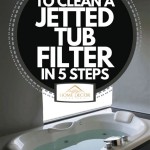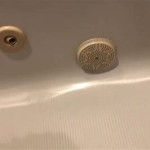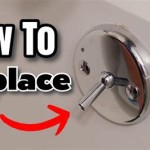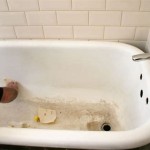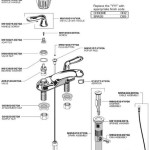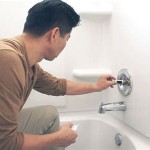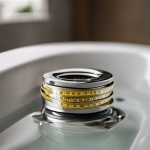Replacing a Bathtub with a Jetted Tub and Shower: A Comprehensive Guide
Remodeling a bathroom is a significant undertaking that can dramatically improve the functionality and aesthetics of a home. One of the most impactful changes a homeowner can make is replacing an existing standard bathtub with a combination jetted tub and shower unit. This project offers a luxurious bathing experience coupled with the practicality of a shower, potentially increasing property value and enhancing daily comfort.
This article provides a detailed overview of the process involved in replacing a standard bathtub with a jetted tub and shower combination, covering essential planning considerations, necessary preparations, installation steps, and potential challenges. This information aims to equip homeowners with the knowledge needed to make informed decisions and potentially manage the project effectively, whether it involves hiring professionals or opting for a do-it-yourself approach.
Key Considerations Before Starting the Project
Before embarking on the installation process, several critical aspects must be thoroughly evaluated. These considerations will significantly influence the scope of the project, the budget, and the overall outcome.
Space Assessment: The first step is to accurately measure the existing bathtub alcove and the surrounding bathroom area. Jetted tubs typically require more space than standard bathtubs, both in terms of length and width. Ensuring sufficient clearance around the tub for movement and access is crucial. Consider the placement of existing fixtures such as the toilet and vanity to determine if any adjustments will be necessary to accommodate the new configuration. Accurate measurements will also guide the selection of the appropriate jetted tub and shower enclosure size and shape.
Plumbing and Electrical Evaluation: Jetted tubs require both plumbing and electrical connections. The existing plumbing lines for the bathtub may need to be modified or relocated to accommodate the jetted tub's drain and water supply connections. A dedicated electrical circuit, typically a Ground Fault Circuit Interrupter (GFCI) protected circuit, is necessary to power the jetted tub's motor and heating system. It's essential to assess the capacity of the existing electrical panel to determine if it can handle the additional load. If the existing plumbing or electrical systems are outdated or inadequate, upgrades may be necessary, adding to the overall project cost and complexity.
Structural Integrity: The floor beneath the bathtub must be able to support the weight of the jetted tub, the water it contains, and the person using it. Jetted tubs, when filled, can weigh significantly more than standard bathtubs. Inspecting the floor joists and subfloor for any signs of damage or weakness is critical. If reinforcement is needed, it should be addressed before installing the new tub. Ignoring this aspect can lead to structural problems and potential safety hazards.
Budget Planning: Establishing a realistic budget is paramount. The cost of the project will depend on factors such as the type and size of the jetted tub, the shower enclosure materials, plumbing and electrical modifications, and labor costs if hiring contractors. Researching the prices of different jetted tub models, shower enclosures, and materials is crucial. Obtaining multiple quotes from qualified contractors can help in accurately estimating labor costs. It is also advisable to allocate a contingency fund to cover unexpected expenses that may arise during the project.
Preparing for the Installation
Once the initial considerations are addressed, preparing the bathroom for the installation process is essential. This stage involves removing the existing bathtub, making necessary plumbing and electrical adjustments, and preparing the surrounding surfaces for the new unit.
Bathtub Removal: The first step is to disconnect the water supply to the existing bathtub. Locate the shut-off valves for the hot and cold water lines and turn them off. If shut-off valves are not present, the main water supply to the house must be turned off. Disconnect the drain and overflow connections from the bathtub. Carefully detach the bathtub from the surrounding walls and flooring. Depending on the type of bathtub and installation method, this may involve removing screws, nails, or adhesive. Use caution to avoid damaging the surrounding walls or flooring during the removal process. Dispose of the old bathtub responsibly, following local regulations for waste disposal.
Plumbing and Electrical Modifications: With the old bathtub removed, the plumbing and electrical systems can be modified to accommodate the jetted tub. Extend or relocate the water supply lines to the new tub's faucet connections. Install the drain and overflow connections according to the manufacturer's instructions. If a new electrical circuit is required, run the wiring from the electrical panel to the location of the jetted tub, ensuring it is properly grounded and protected by a GFCI breaker. It is highly recommended to consult with a qualified electrician for this step to ensure compliance with electrical codes and safety regulations.
Surface Preparation: The walls surrounding the bathtub alcove need to be prepared for the installation of the shower enclosure. Remove any existing tiles, wallpaper, or paint. Repair any damaged areas of the walls, such as cracks or holes. Apply a waterproof membrane or sealant to the walls to prevent water damage. Ensure that the walls are level and plumb to provide a smooth surface for the shower enclosure installation. The flooring should also be inspected and repaired if necessary. Consider installing a new waterproof flooring material around the tub area to protect against water damage.
Installing the Jetted Tub and Shower Enclosure
The installation phase requires meticulous attention to detail and adherence to the manufacturer's instructions. This process typically involves setting the jetted tub, connecting the plumbing and electrical systems, and installing the shower enclosure.
Jetted Tub Installation: Carefully position the jetted tub in the prepared alcove. Ensure that it is level and properly aligned. Connect the water supply lines to the tub's faucet connections, using appropriate fittings and sealants to prevent leaks. Connect the drain and overflow connections to the plumbing system. Secure the tub to the floor according to the manufacturer's instructions. This may involve using shims to level the tub and applying adhesive to the floor. Test the tub's plumbing system for leaks by filling it with water and checking all connections. If any leaks are detected, tighten the connections or replace the fittings as needed.
Electrical Connection: Connect the jetted tub's electrical wiring to the dedicated GFCI circuit. Ensure that the wiring is properly grounded and protected by a junction box. Follow the manufacturer's instructions for wiring connections. It is highly recommended to have a qualified electrician perform this step to ensure compliance with electrical codes and safety regulations. Test the jetted tub's electrical system by turning on the power and verifying that the motor and heating system are functioning properly.
Shower Enclosure Installation: Install the shower enclosure according to the manufacturer's instructions. This may involve assembling the enclosure frame, installing the glass panels or doors, and sealing the joints with silicone caulk to prevent water leaks. Ensure that the enclosure is properly aligned and plumb. Install the showerhead, faucet, and other accessories. Test the shower enclosure for leaks by running water and checking all connections. If any leaks are detected, tighten the connections or apply additional sealant as needed.
Potential Challenges and Solutions
Despite careful planning and preparation, unforeseen challenges can arise during the installation process. Being aware of these potential issues and having solutions in mind can help to minimize delays and ensure a successful outcome.
Unexpected Plumbing Issues: Existing plumbing lines may be corroded, damaged, or in poor condition, requiring unexpected repairs or replacements. Solutions may involve replacing sections of the plumbing with new pipes, installing new shut-off valves, or rerouting the plumbing to accommodate the jetted tub's connections. Consult with a qualified plumber to assess the situation and recommend the appropriate course of action.
Electrical Code Violations: Existing electrical wiring may not meet current electrical codes, requiring upgrades or modifications to ensure safety and compliance. Solutions may involve running new wiring, installing a dedicated GFCI circuit, or upgrading the electrical panel. A qualified electrician should be consulted to identify any electrical code violations and perform the necessary corrections.
Incorrect Measurements: Inaccurate measurements can lead to problems with the fit of the jetted tub or shower enclosure. Solutions may involve modifying the alcove to accommodate the tub or enclosure, or returning the incorrect unit and ordering the correct size. Double-checking all measurements before ordering materials is crucial to prevent this issue.
Difficult Access: Limited access to the bathroom can make it challenging to maneuver the jetted tub and shower enclosure into place. Solutions may involve temporarily removing doors or windows to create a wider opening. Carefully planning the delivery route and having sufficient manpower can also help to overcome this challenge.

Replacing That Large Tub No Uses Anymore Superior Construction And Design Llc

Replacing That Large Tub No Uses Anymore Superior Construction And Design Llc

Installing A Whirlpool Tub What To Know My Buddy The Plumber Electric Heating Air

The Pros Cons Of Replacing A Shower Tub Combo With Degnan Design Build Remodel

Renovated Master Bath To Remove Old Jacuzzi Tub And Enlarge Very Small Shower

Replacing That Large Tub No Uses Anymore Superior Construction And Design Llc

Removing Jetted Tub And Replacing With Freestanding Tips Hometalk

Whirlpool Shower Combo To Replace In Master Bath

How To Remove A Jetted Bathtub

Goodbye Jetted Tub O Custom Shower Highcraft
Related Posts

